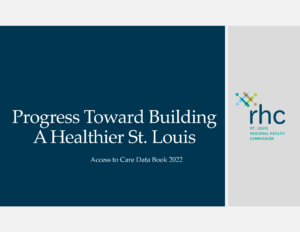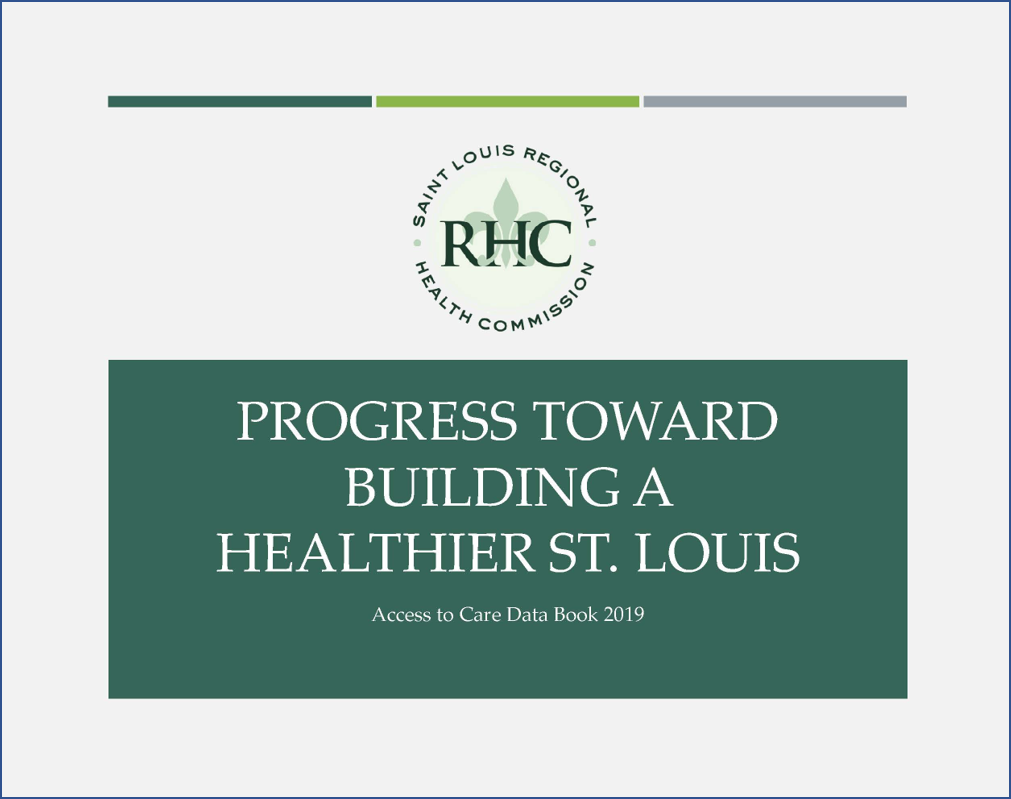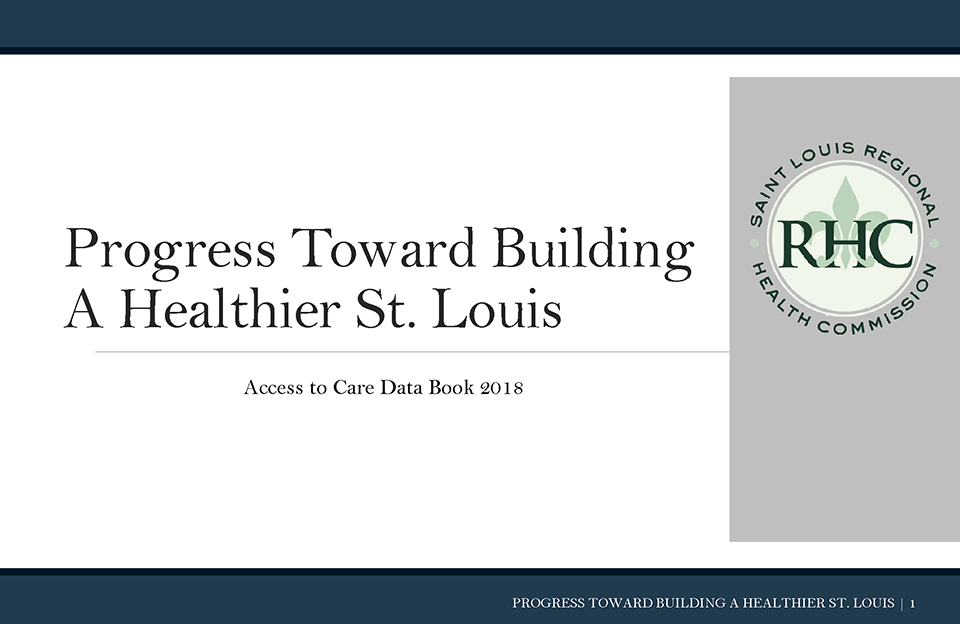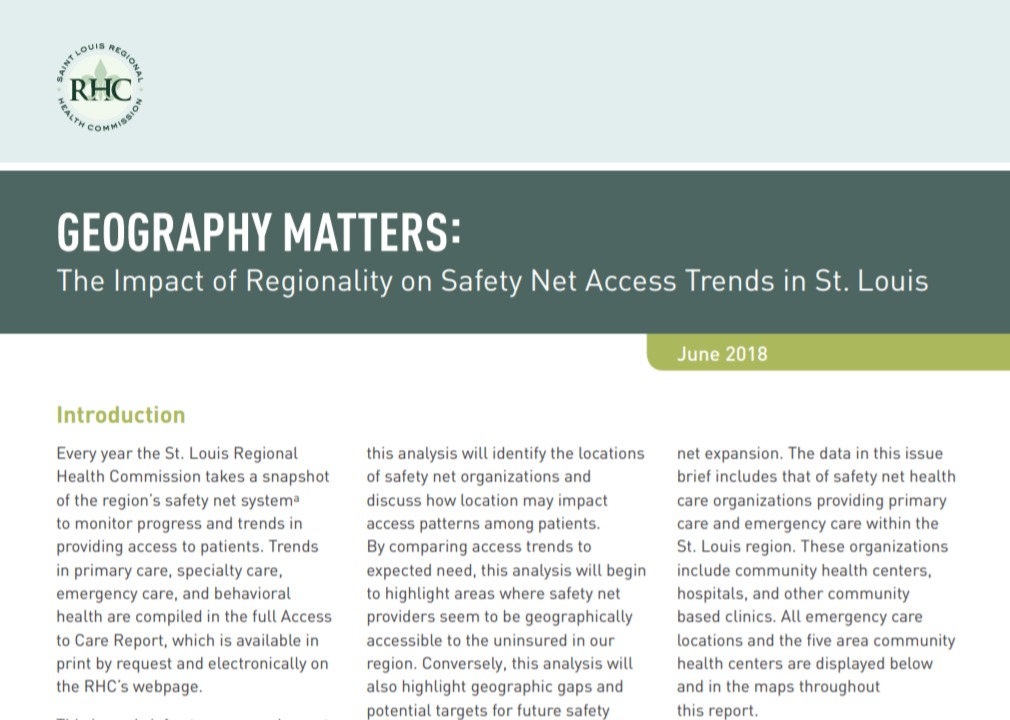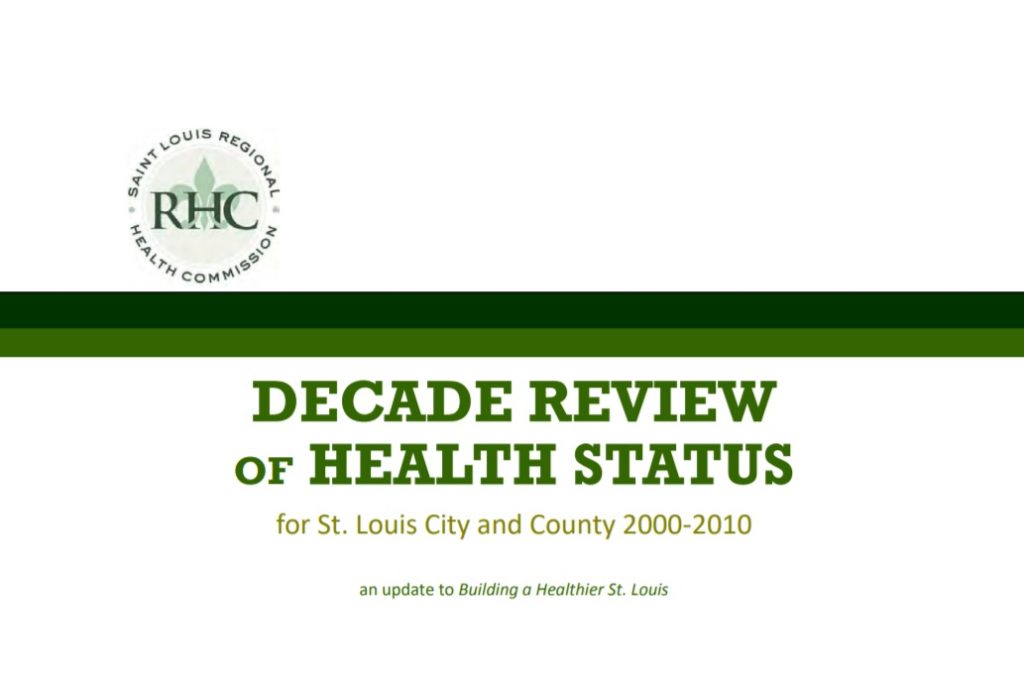The Regional Health Commission produced an annual “Access to Care” data book, which reviews community-wide progress toward strengthening the health care safety net system in the region. Data is gathered from safety net provider institutions across St. Louis City and County. We can use this information to:
- Assess the current capacity of the region’s health care safety net
- Leverage data to advocate for improved health care policy
- Elevate the lived experience of uninsured and underinsured patients across the health care system
- Address social determinants of health
- Work as a region to improve health outcomes and increase access to care
Executive Summary
- The overall rate of uninsured individuals has continued to steadily decline in both St. Louis City and County over the past four years. In Missouri, the number of uninsured individuals decreased by 6% over the past year, while remaining relatively stable since 2017.
- There continues to be a shift in the payor mix of St. Louis safety net organizations.
- Wait times across primary and specialty care safety net sites continue to lengthen over time.
Key Findings
- The number of individuals without health insurance coverage in St. Louis City and County remained relatively stable over the past year while decreasing by 21% over the past four years. Of the more than 90,300 users without health insurance coverage in St. Louis City and County, 46% identified as African American/Black, 42% White, and 16% “Other”. Over the past four years, the racial composition of the uninsured has remained stable (page 5).
- There have been notable changes in payor mix over the past four years. Privately insured users have decreased by 12%, and uninsured users have decreased by 30% since 2017. Similar trends have been seen in encounters over the past four years. Privately insured encounters have decreased by 17%, and uninsured encounters have decreased by 19% since 2017 (pages 25 and 29).
- Safety net primary care providers served roughly 70% of the total uninsured population in St. Louis City and County in 2020 (page 28).
- Total primary care (medical, dental, and behavioral health) encounters at safety net organizations decreased by 21% over the past four years (page 35).
- Medical encounters have declined by 18% over the past year and by 28% over the past four years (page 33).
- Dental encounters at safety net primary care providers have decreased by 44% over the past year and 53% over the past four years (page 42).
- Behavioral health encounters at safety net primary care providers have declined by 5% over the past year and 5% since 2017 (page 44).
“Many adults that want to utilize healthcare services work their full-time or part-time jobs during the hours that most FQHC’s [Federally Qualified Health Centers] are open. This contributes to these individuals seeking out urgent care services (some that don’t necessarily take Gateway payment) or going to a 24-hour Emergency Department because they know they will be seen.”
Support Staff at Safety Net Provider Organization
- Total emergency department encounters have declined by 18% over the past year. Uninsured emergency department encounters at St. Louis area hospitals have decreased by 13% from 2017 to 2020 (pages 55 and 59).
- Non-emergent encounters have decreased by 28% over the past year. Non-emergent encounters decreased by 39%, 28%, 23%, and 22% among uninsured, Medicaid, Medicare, and privately insured patients, respectively, over the past year (page 62).
- Approximately 14,700 patients visiting St. Louis area emergency departments had at least four emergency department visits at the same hospital, representing 4% of all emergency department patients in 2020 (page 67). Among these patients, there were more than 84,565 emergency department encounters in 2020 (page 68).
- Emergency department encounters with behavioral health diagnoses (primary) have decreased by 10% and account for 7% of all emergency department encounters in 2020 (page 69). The top primary behavioral health diagnoses are mood disorders, schizophrenia/delusional disorders, and alcohol use disorders (page 70).
“Appointments for many specialties are booked several months out. When an urgent appointment is requested patients don’t hear from anyone and have to call the streamline dept. where they are told the notes are in review. The referral dept. is great but the clinics are very difficult.”
Support Staff at Safety Net Provider Organization
- Total specialty care users and encounters at St. Louis area specialty care organizations decreased by 33% and 13%, respectively, since 2017. This decline represents more than 182,400 fewer users and more than 178,300 fewer encounters (pages 80 and 82).
- Of the more than 462,300 specialty care users in 2020, approximately 74% were White, 20% were African American/Black and 8% were from the “Other” racial category (page 81).
- Over the past year, uninsured specialty care users decreased by 35%, while uninsured specialty care encounters decreased by 14% (pages 80 and 84).
- Medicaid specialty care encounters decreased by 15% over the past year and 17% since 2017 (page 86).
- While wait times for some specialty care appointments have either decreased or remained the same, gastroenterology, rheumatology, and pulmonology trend with the longest average wait times for both new and returning patients (pages 88 and 89).
- Users increased over the last year and since 2017 (page 94).
- Behavioral health users served increased 17% to 40,556 in 2019, as compared to 36,713 served in 2018. Total users served have increased by 29%, or nearly 6,666 people, since 2017 (page 94).
- Behavioral health users served increased 12% to 45,289 in 2020, as compared to 40,556 served in 2019. Total users served have increased by 34%, or nearly 11,399 people, since 2017 (page 94).
- Newly admitted users to behavioral health safety net agency programs increased by 5% to 14,455 in 2019 and increased by 21% to 17,433 users in 2020. Newly admitted users accounted for 41% of all users served in 2019, and 43% of all users served in 2020 (page 95).
- Wide variation exists in the rate of serving the safety net population within the designated service areas of respective behavioral health safety net administrative agents in Missouri’s Eastern Region (page 96).
- Behavioral health encounters at safety net primary care providers decreased by 13% over the past year, and by 12% since 2017 (page 97).
- Emergency department encounters with behavioral health diagnoses (primary and secondary) have decreased over the past year and account for 33% of all emergency department encounters in 2020 (page 108). The top primary behavioral health diagnoses remain mood disorders, schizophrenia/delusional disorders, and alcohol use disorders (page 104).
- Acute psychiatric inpatient encounters decreased overall in 2019, inpatient psychiatric staffed bed capacity increased by 21.7% since 2018 and 14% since 2017 (page 113).
- Acute psychiatric inpatient encounters decreased overall in 2020, inpatient psychiatric staffed bed capacity increased by 0.5% since 2019 and 15% since 2017 (page 114).
Additional Information
For the purposes of the “Access to Care” data book, individuals enrolled in Gateway to Better Health at the time of publishing were categorized into the “Uninsured” payor category. Gateway to Better Health (GBH) was a temporary health care program designed to provide uninsured adults a bridge in care until they are able to enroll in health care options provided by the Affordable Care Act. In August 2020, Missouri voters approved Medicaid expansion across the state. Those that were enrolled in GBH are now likely to transition to full Medicaid coverage. Learn more about Gateway to Better Health here and Medicaid expansion here.
Learn more by viewing our Workgroup Membership Roster (PDF).
Related Data
This issue brief acts as a supplement to data provided in the 2017 Access to Care report and focuses on geographic access trends among uninsured patients. Utilizing patients’ zip code of residence, this issue brief tracks the number of uninsured patients living in St. Louis City and County who were served by local safety net providers.
This review provides a comprehensive summary of leading health indicators and disparity metrics in St. Louis City and County from 2000-2010.
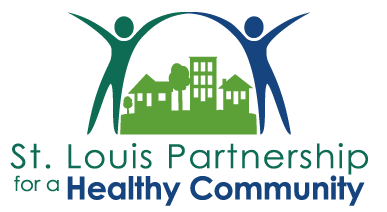
Think Health St. Louis is a web-based source of population data and community health information. The RHC was a Founding Partner of the St. Louis Partnership for a Healthy Community that developed the Community Health Assessment (CHA) and Community Health Improvement Plan (CHIP).
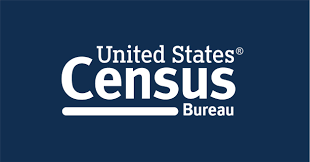
Data.census.gov is the new platform to access data and digital content from the U.S. Census Bureau. The RHC utilizes Census Data in conjunction with the Access to Care information collected for these reports.
Questions?
To learn more about the Access to Care Data Book, please contact Blessing Kuebee.

